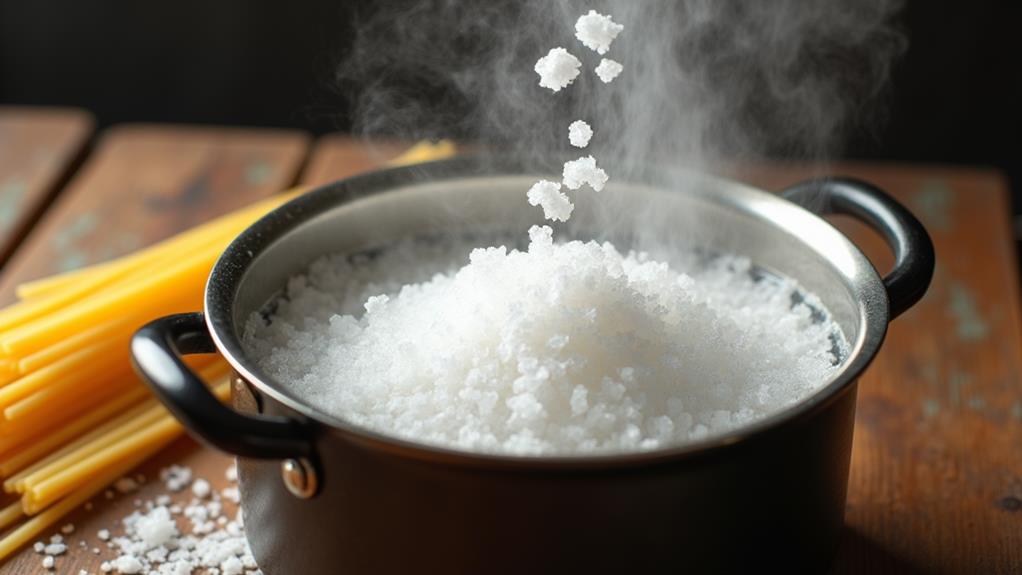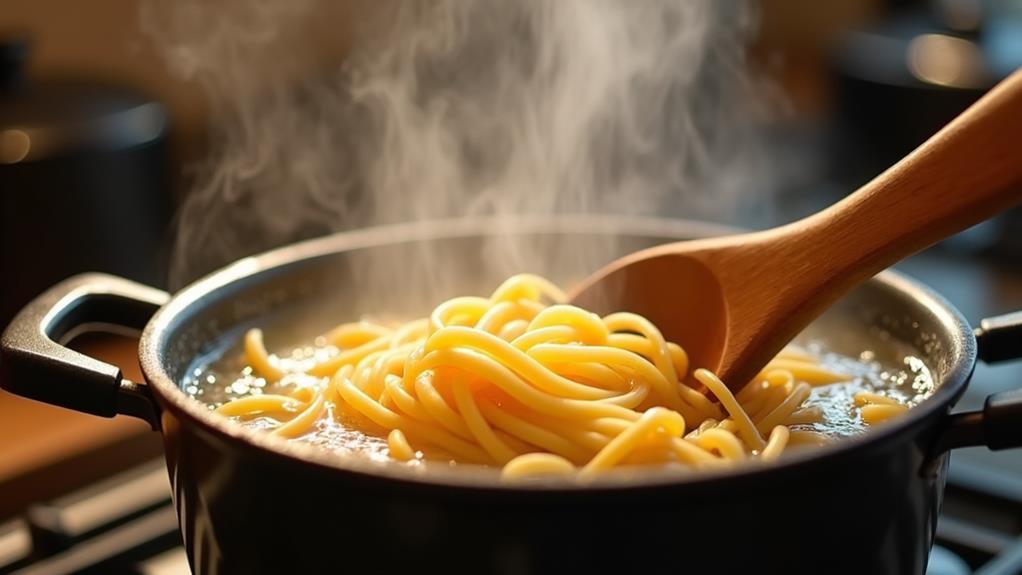To master perfectly cooked pasta, start by selecting the right tools and ingredients. Use a large pot with 4-6 quarts of water per pound of pasta, and add salt until it tastes like seawater. Bring the water to a rolling boil before adding your pasta. Stir immediately to prevent clumping, and maintain the boil throughout cooking. Follow package instructions for timing, but start testing for doneness about a minute early. Look for uniform color and a slightly firm texture when biting. Avoid common mistakes like overcooking or rinsing after draining. With practice, you'll refine your techniques and preferences for pasta perfection.
Gather Your Pasta Arsenal
Before you embark on your pasta-cooking journey, you'll need to assemble your tools and ingredients. Start by selecting your preferred pasta types, ranging from classic spaghetti to innovative artisanal shapes.
Ensure you have a large, heavy-bottomed pot for boiling, a colander for draining, and long-handled tongs or a pasta fork for stirring and serving. Don't forget a reliable timer to track cooking time precisely.
Your cooking equipment should include a sharp knife for ingredient prep and a wooden spoon for gentle stirring. A large, shallow bowl for serving and mixing sauce is essential.
Consider investing in a pasta measure to portion accurately, especially when experimenting with new recipes. For those seeking culinary innovation, a pasta machine can open up a world of homemade pasta possibilities.
Stock your pantry with high-quality olive oil, sea salt, and freshly ground black pepper. These basics elevate any pasta dish.
The Perfect Water-to-Pasta Ratio
When it comes to cooking pasta, getting the water-to-pasta ratio right is crucial for achieving the perfect texture and taste.
You'll want to measure your pasta carefully and use enough water to allow it to move freely while cooking, which typically means about 4 to 6 quarts of water per pound of pasta.
This balance ensures that there's enough water to maintain the right starch concentration, preventing your pasta from becoming too sticky or gummy as it cooks.
Measuring for Success
The perfect water-to-pasta ratio is crucial for achieving ideally cooked pasta. To master this essential cooking method, you'll need to focus on precise measurements.
Start by considering the pasta shapes you're using, as different types require varying amounts of water. For portion control and optimal sauce pairing, measure your pasta carefully before cooking.
When it comes to measuring for success, keep these three key points in mind:
- Use a kitchen scale to weigh your pasta accurately, ensuring consistent results every time.
- Measure water using a clear, graduated container for precise volume control.
- Consider the pot size in relation to your pasta quantity, allowing enough room for expansion.
Balancing Starch Concentration
Achieving the perfect water-to-pasta ratio is essential for balancing starch concentration and ensuring your pasta cooks evenly. The ideal ratio is typically 4 quarts (16 cups) of water for every pound of pasta. This generous amount of water serves two crucial purposes: it maintains a rolling boil throughout the cooking process and dilutes the starch released by the pasta.
When you use too little water, the starch release becomes concentrated, resulting in gummy, sticky pasta. Conversely, using the right amount of water allows the starch to disperse evenly, preventing clumping and promoting uniform cooking. This cooking method also helps maintain the pasta's texture and flavor.
To further optimize your pasta's consistency, consider these innovative techniques: adding a pinch of salt to the water to enhance flavor, and stirring the pasta occasionally to prevent sticking.
Remember, different pasta shapes may require slight adjustments to the water-to-pasta ratio. For instance, long pasta like spaghetti might need more water to fully submerge, while shorter shapes like penne may require less.
Salting: The Flavor Foundation

Salt, the unsung hero of pasta preparation, plays a crucial role in elevating your dish from bland to brilliant. When it comes to salting techniques, timing is everything. You'll want to add salt to your water just as it begins to boil, allowing it to dissolve fully before introducing the pasta. This ensures even flavor absorption throughout the cooking process.
Different salt types can impact your pasta's final taste. Consider these options:
- Kosher salt: Large, flaky crystals that dissolve quickly and enhance pasta's natural flavors.
- Sea salt: Offers a more complex mineral profile, adding subtle nuances to your dish.
- Table salt: Fine-grained and iodized, it's readily available but can impart a slightly metallic taste.
The amount of salt you use depends on various factors, including pasta varieties and water hardness. As a general rule, aim for water that tastes like the sea.
This may seem excessive, but remember that pasta only absorbs a fraction of the salt during cooking. By properly seasoning your water, you're laying the foundation for a perfectly balanced dish that won't require excessive salting at the table.
Achieving the Rolling Boil
One of the most crucial steps in pasta preparation is reaching the perfect rolling boil. This vigorous state of water ensures even cooking and prevents your pasta from sticking together.
To achieve this, you'll need the right boiling equipment: a large pot that allows your pasta types to move freely. Fill it with fresh, cold water, leaving enough room for the pasta to expand.
Place the pot on your stove's largest burner and crank up the heat to high. As the water heats, you'll notice small bubbles forming at the bottom. These will gradually increase in size and frequency.
Don't be tempted to add your pasta too soon; patience is key. Wait until you see large, continuous bubbles breaking the surface rapidly. This is your rolling boil.
Maintain this intense boil throughout the cooking process by keeping the heat high. If you're cooking long pasta types like spaghetti or linguine, you may need to stir occasionally to ensure they're fully submerged.
With shorter pasta shapes, a quick initial stir should suffice. Remember, a proper rolling boil is your ticket to perfectly cooked pasta every time.
Submerging and Stirring Techniques

The moment of truth arrives when you're ready to add your pasta to the boiling water. As you prepare to submerge your chosen pasta shapes, remember that precision is key. Hold the pasta over the pot and gently lower it in, allowing the water's rolling boil to envelop each strand or piece.
Once submerged, immediately begin stirring to prevent clumping and ensure even cooking.
Different pasta shapes require unique stirring methods. For long noodles like spaghetti or linguine, use a fork to gently separate the strands as they soften. Shorter pasta shapes benefit from a circular stirring motion with a wooden spoon. Throughout the cooking process, stir occasionally to maintain separation and promote uniform heat distribution.
To create a vivid image of proper pasta submersion, visualize these steps:
- Slowly lower the pasta into the water, feeling the steam rise against your hands
- Watch as the rigid noodles gradually soften and bend beneath the surface
- Observe the water's turbulence as you stir, creating small whirlpools that dance around the pasta
Timing and Testing Doneness
Mastering the art of perfectly cooked pasta hinges on two crucial elements: timing and testing for doneness. As you embark on your culinary journey, remember that pasta cooking times can vary significantly based on the type and thickness of the noodles.
Begin by referring to the package instructions, but don't rely on them entirely. Instead, set a timer for one minute less than the suggested cooking time.
As you approach the final minutes, it's time to engage in taste testing and texture evaluation. Using a slotted spoon, retrieve a single pasta piece and bite into it. The ideal texture, known as "al dente," should offer a slight resistance to your teeth while remaining tender.
If you're uncertain, continue cooking and testing at 30-second intervals. Pay attention to the pasta's center; it shouldn't have a chalky or overly firm core. For a more visual approach, cut a piece of pasta in half. A properly cooked noodle will have a uniform color throughout, with no visible white or opaque areas in the center.
Frequently Asked Questions
Can I Use Oil in the Pasta Water?
You can add oil to pasta water, but it's not recommended. While it's believed to reduce pasta stickiness, the oil benefits are minimal. Instead, try stirring your pasta frequently and using ample water for better results.
How Long Can I Store Cooked Pasta in the Refrigerator?
You've got 3-5 days to enjoy your cooked pasta before pasta spoilage sets in. Maximize pasta storage by keeping it in an airtight container. For a game-changing twist, try freezing portions for quick, innovative meals later.
Is It Necessary to Rinse Pasta After Cooking?
Like a culinary alchemist, you're navigating the pasta realm. Don't rinse your pasta after cooking; it'll wash away the starchy coating. This coating enhances pasta texture and sauce adherence, elevating your dish to innovative gastronomic heights.
What's the Best Way to Reheat Leftover Pasta?
You'll love these innovative reheating methods! For saucy pasta, microwave with a splash of water. For plain pasta, quickly sauté in a pan. Pair your reheated pasta with a fresh sauce for a gourmet twist.
Can I Cook Different Pasta Shapes Together in the Same Pot?
Excitement meets caution! You can mix pasta shapes, but be mindful of cooking time differences. For innovative results, pair shapes with similar pasta shape compatibility. Stagger additions or opt for quick-cooking varieties to ensure perfectly al dente pasta every time.
Final Thoughts
You've now mastered the essentials of perfect pasta preparation. By gathering your tools, measuring precisely, salting generously, and achieving the right boil, you've laid the foundation for success. Your stirring technique ensures even cooking, while your timing skills prevent overcooking. Remember, practice makes perfect. With each batch, you'll refine your skills, developing an intuitive sense for pasta perfection. Soon, you'll be crafting restaurant-quality dishes with ease, delighting friends and family with your newfound culinary expertise.















